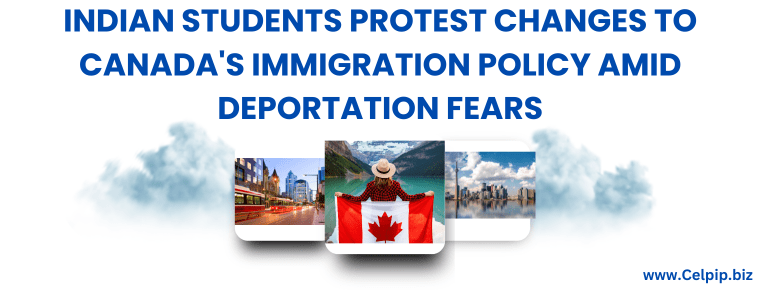Numerous international students seek for Canada PR who aspire to live in Canada see their dreams unfold in the same way that maple leaves do against a snowy backdrop, so it becomes important to know how to get Canada PR after 2024 for International Students.
However, given the recent cap on study permits and the changing immigration laws, pursuing permanent residency (PR) in the post-2024 environment may seem like a dangerous journey.
This article, which carefully explains the nuances of Canadian PR choices, such as the Canadian Experience Class and Provincial Nominee Programs, will serve as your compass.
With the right tactics and perceptive analysis, you may turn the seemingly impossible into a bright route that leads to your Canadian goals.
A Summary of Recent Changes to Canada Study Visa Policies
On January 22nd, 2024, Canada announced a temporary two-year cap on the number of new study permits issued to international students.
This significant policy change has generated considerable discussion and is expected to impact aspiring international students planning to study in Canada. Here’s a summary of the key points:
The Cap
- Reduction – The cap translates to a 35% decrease in new study permits compared to 2023 levels, amounting to approximately 364,000 approvals in 2024.
- Duration – The cap will be in effect for two years, 2024 and 2025.
- Allocation – Provincial and territorial governments will receive cap allocations based on population.
Rationale
- Housing Crisis – The Canadian government cites concerns about the housing crisis and its link to rising immigration numbers, including international students. They aim to address the housing strain and ensure sustainable population growth.
- Program Integrity – Concerns about program integrity within the student visa system are another factor. The government hopes to prevent unscrupulous institutions from exploiting students for financial gain.
- Quality Education – Ultimately, the goal is to ensure international students receive a high-quality education and have a successful experience in Canada.
Additional Measures
- Study Permit Application Attestation – Starting January 22nd, all study permit applications require an attestation letter from the relevant province or territory, verifying the intended program meets provincial priorities.
- Post-Graduation Work Permit (PGWP) Changes – From September 2024, students enrolled in programs delivered through public-private partnerships will no longer be eligible for PGWPs. Open work permits for spouses of international students will also be restricted.
Impact
- Students – International students considering Canada as a study destination will face higher competition for fewer available spots.
- Institutions – Canadian educational institutions may experience a decline in international student enrollment, impacting finances and program offerings.
- Economy – The economic contributions of international students may decrease, requiring adjustments in certain sectors.
Future
- The government plans to reassess the cap in 2025 after monitoring its effectiveness.
- Ongoing discussions and potential policy changes regarding Canada’s international student program are likely to continue.
Check all changes on the official website by clicking here!
It’s important to stay informed about the latest developments and consult official sources for detailed information if you’re planning to study in Canada.
Permanent Residence Procedure for International Students in Canada – Before
Obtaining a PR Card and becoming a permanent resident was the ultimate dream of many Indians who applied for Canada student visa.
Although a time-consuming process requiring a lot of hardwork and dedication, the end result was always a dream come true with a lot of hopes for the future.
Let’s understand how the process worked before the recent changes:
- Study in Canada: International students need to first come to Canada for their studies. They enrolled in a Designated Learning Institution (DLI) and completed a program that was at least eight months long.
- Post-Graduation Work Permit (PGWP): After completing their studies, students would be eligible for a Post-Graduation Work Permit (PGWP). This permit allows them to work in Canada for a certain period, usually up to three years, depending on the length of the program completed.
- Gain Canadian Work Experience: To be eligible for PR through various immigration programs, applicants often needed to gain Canadian work experience. This was achieved through the PGWP or other work permits.
- Express Entry System: Many applicants used the Express Entry system, which manages the applications for three federal economic immigration programs: the Federal Skilled Worker Program (FSWP), the Federal Skilled Trades Program (FSTP), and the Canadian Experience Class (CEC).
- Language Proficiency and Educational Credentials: Applicants were required to take language proficiency tests (usually IELTS for English or TEF for French) and have their educational credentials assessed by recognized organizations.
- Comprehensive Ranking System (CRS): Under Express Entry, candidates were given points based on factors like age, education, work experience, language proficiency, and adaptability. The highest-ranking candidates were then invited to apply for permanent residency.
- Invitation to Apply (ITA): Those who received an Invitation to Apply then submitted their application for permanent residency.
- Permanent Residency Application: Applicants needed to submit all required documents and pay the necessary fees for their PR application. Medical exams and police clearances were typically part of this process.
- Wait for Processing: After submitting the application, there was a waiting period during which the application was processed.
- Receive Confirmation of PR Status: If the application was successful, applicants received confirmation of their permanent residency status in Canada.
Impact of Recent Changes on PR Process for International Students
The recent policy changes in Canada, including the cap on international student visas and revisions to the Post-Graduation Work Permit (PGWP) program, have undoubtedly impacted the path to permanent residency (PR) for international students.
Here’s a breakdown of the potential consequences:
Increased Competition
- Fewer study permits granted will lead to a smaller pool of eligible candidates for PR programs like the Canadian Experience Class (CEC).
- This means international students need to be highly competitive, with strong Canadian work experience and language skills, to stand out in the pool.
Shifting Emphasis
- Reduced access to PGWPs for certain students might make programs with guaranteed post-study work placements or those aligned with provincial priorities more attractive.
- Provincial Nominee Programs (PNPs) may see increased interest as an alternative route to PR, while Express Entry, based on federal points, might become less accessible.
Uncertainty and Adaptability
- Policy changes create a fluid environment, requiring international students to remain updated and adaptable to navigate the evolving landscape.
- Early engagement with immigration consultants and careful tailoring of study and work choices can increase adaptability and ensure alignment with evolving requirements.
Potential Benefits
- The focus on quality education and program integrity within the student visa system could benefit qualified students by ensuring a more robust educational experience.
- Increased emphasis on Canadian experience and relevant skills through work could ultimately strengthen the pool of PR candidates, leading to a more skilled workforce.
Overall, the impact of recent changes is multifaceted, demanding strategic planning and flexibility from international students aiming for PR.
Staying informed, actively building Canadian experience, and aligning oneself with provincial priorities is crucial for navigating the new landscape and achieving the coveted maple leaf.
Tips for Getting Canada PR After Recent Changes in 2024
While the recent changes to Canada’s immigration policies, including the cap on international student visas and adjustments to the Post-Graduation Work Permit (PGWP) program, have made the path to permanent residency (PR) more challenging for international students, it’s not impossible.
Here are some tips to navigate the new landscape and increase your chances of success:
1. Master the Canadian Experience Class (CEC)
The CEC remains a key pathway for international students with Canadian work experience. Aim for at least one year of skilled work experience in Canada after graduation.
2. Focus on Provincial Nominee Programs (PNPs)
PNPs offer targeted pathways to PR based on provincial needs. Research PNP programs in provinces aligned with your skills and study program.
3. Hone your Language Skills
Strong English or French language skills are essential for most PR programs. Take language tests like IELTS or TEF early on to meet the required score.
CELPIP is the best test to give for Canada PR, start free practice now at www.celpipstore.com!
4. Gain Relevant Work Experience
Prioritize work experience in fields facing labor shortages in Canada, such as healthcare, STEM, and skilled trades.
5. Network and build connections
Connect with professionals in your field in Canada. Attend industry events and build relationships that could lead to job opportunities.
6. Seek Professional Guidance
Consider consulting an immigration consultant to navigate the complex application process and maximize your chances of success.
7. Stay Informed and Adapt
Immigration policies are constantly evolving. Stay updated on the latest changes and adapt your strategies accordingly.
Bonus Tip – Consider studying in a program with a guaranteed post-study work placement or co-op opportunities.
This will give you valuable Canadian work experience and make you more competitive for PR programs.
Remember, getting Canada PR is a marathon, not a sprint. Be patient, persistent, and strategic in your approach, and you’ll increase your chances of achieving your Canadian dream.
Conclusion
In conclusion, the pursuit of permanent residency (PR) in Canada for international students after the policy changes in 2024 may seem challenging, but it is far from impossible.
This article has provided a comprehensive guide to navigating the altered landscape, emphasizing the importance of staying informed and adapting to changes.
The recent cap on study permits and revisions to the Post-Graduation Work Permit (PGWP) program have undoubtedly shifted the dynamics, increasing competition and altering the emphasis on certain pathways.
International students are encouraged to explore alternative routes such as the Canadian Experience Class (CEC) and Provincial Nominee Programs (PNPs), align themselves with provincial priorities, and focus on building relevant skills and work experience.
Language proficiency, professional networking, and seeking guidance from immigration consultants are crucial components of a successful PR strategy.
The evolving nature of immigration policies necessitates continuous vigilance and flexibility, ensuring that aspiring candidates are well-prepared to navigate the complex journey towards achieving their Canadian dream.
Remember, obtaining Canada PR is a marathon, requiring patience, persistence, and a strategic approach.
Don’t let policy changes derail your aspirations; instead, stay determined and informed on the path to making Canada your home.
Good luck!
Frequently Asked Questions on Canada PR after 2024 for International Students
How can an international student get PR fast in Canada?
Express Entry under CEC offers the fastest route, but Canadian work experience is key.
Can I go to Canada in 2024?
Yes, but specific immigration programs offer pathways – explore Express Entry and Provincial Nominee Programs.
Is Canada giving PR to all international students?
Absolutely not, PR is competitive and merit-based.
How many years do you need to be in Canada to get PR?
Minimum is 3 years under specific programs like CEC.
Which province is easy to get PR in Canada?
Difficulty varies, research programs aligned with your profile in provinces like Manitoba or Saskatchewan.
Summary
1. Adapt to post-2024 changes and keep updated
2. Explore CEC and PNPs
3. Prioritize Canadian work experience’
4. Select programmes that guarantee PGWP
5. Seek professional immigration advice
6. Persist strategically for Canada PR




